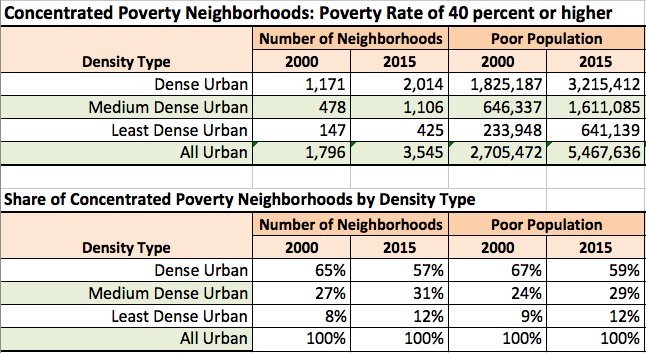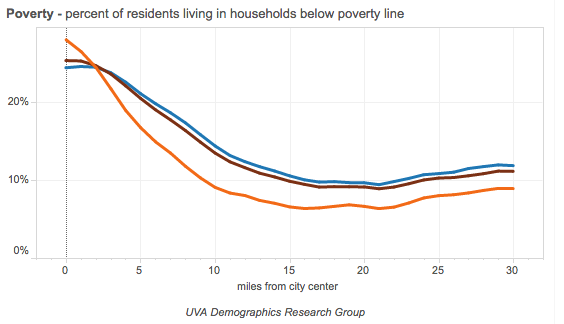Since 2000, the number of people living in extremely poor neighborhoods has doubled; neighborhoods of concentrated poverty are still disproportionately in the densest urban places.
Last week, the Joint Center on Housing Studies released its annual “State of the Nation’s Housing” report. While most of the report focuses on new housing construction, and the slow and uneven rebound in home prices in the wake of the collapse of the housing bubble, there’s some alarming data on the growth of concentrated poverty.
Being poor is hardship in itself. But growing up in a neighborhood where a large fraction of your peers are also poor has been shown to have devastating consequences for the lifetime prospects of children living in these neighborhoods. Growing up in concentrated poverty increases your exposure to and risk of becoming involved in crime, worsens your health, lowers your chances of marriage, and reduces your employment prospects and lifetime earnings.
As we’ve emphasized in our report Lost in Place, despite all of the attention that’s given to gentrification, the big story in urban neighborhood change is the steady, and much larger growth of neighborhoods of concentrated poverty. Our work looked at a 40 year period from 1970 to 2010, and noted that nearly all of the neighborhoods that were poor in 1970 were still poor four decades later.
The new JCHS study examines the change in concentrated poverty from 2000 through 2015. Nationally, the poverty rate increased significantly over this time period, a product of sluggish economic growth in most of the first decade of the millennium, growing income inequality and the devastating effects of the Great Recession. So it’s little surprise that the overall number of people in poverty–from 34 million in 2000 to 48 million in 2015–and the number of extremely poor neighborhoods increased over that time period.
The JCHS data show that concentrated poverty increased even faster. The number of poor people living in neighborhoods of concentrated poverty in metropolitan areas more than doubled between 2000 and 2015, from 2.7 million to more than 5.4 million JCHS uses a 40 percent threshold as their definition of extreme poverty (at least 40 percent of the households living in a census tract have incomes lower than the federal poverty line. The number of neighborhoods with poverty rates in excess of 40 percent in metro areas also nearly doubled, from about 1,800 to more than 3,500.
Concentrated poverty is disproportionately found in dense city neighobrhoods
The JCHS study provides a useful geographic disaggregation of the location of high poverty neighborhoods. For each US metropolitan area, they divide the census tracts that compose that metro area into three groups, based on density, and then tabulate the poverty rate for each of these three groups.
The data are shown here. (We’ve excluded the data for non-metropolitan areas, and presented our own calculations, based on the JCHS data, to show the share of the number of poor persons living in each of the three density categories).

Almost three-fifths of all of the persons living in neighborhoods of concentrated poverty live in the densest one-third of all of the nation’s metropolitan census tracts. Although the share of the poor living in these dense areas has declined slightly (from about two-thirds to about three-fifths), the densest neighborhoods are still about twice as likely as medium density neighborhoods to have concentrated poverty; and are about five times as likely to have concentrated poverty as the least dense urban neighborhoods.
Its still very much the case that poverty rates are much higher closer to city centers than at the urban periphery. Luke Juday’s summary of the data for the 50 largest US metro areas makes it clear how strong this pattern is, and how little it has changed over the past 25 years. The poverty rate within 5 miles of the center of large metro areas (which are almost always the densest neighborhoods) are more than double, on average, the poverty rates 15 or more miles away from the center. (The orange line is poverty rate in 1990, the purple and blue lines show 2012 and 2015 respectively).
While it is true that poverty is growing faster in suburbs (in the aggregate) than in cities, it is still the case that poverty rates are much higher, and the incidence of concentrated poverty is much more common in cities than in suburbs. In addition, aggregated data about suburban poverty masks the fact that suburban poverty is itself concentrated in older, inner ring suburbs, and not distributed evenly in all suburbs. As we’ve pointed out before, there’s precious little evidence for claims of a Paris-style inversion where the rich live disproportionately in cities while the poor live in suburbs.

